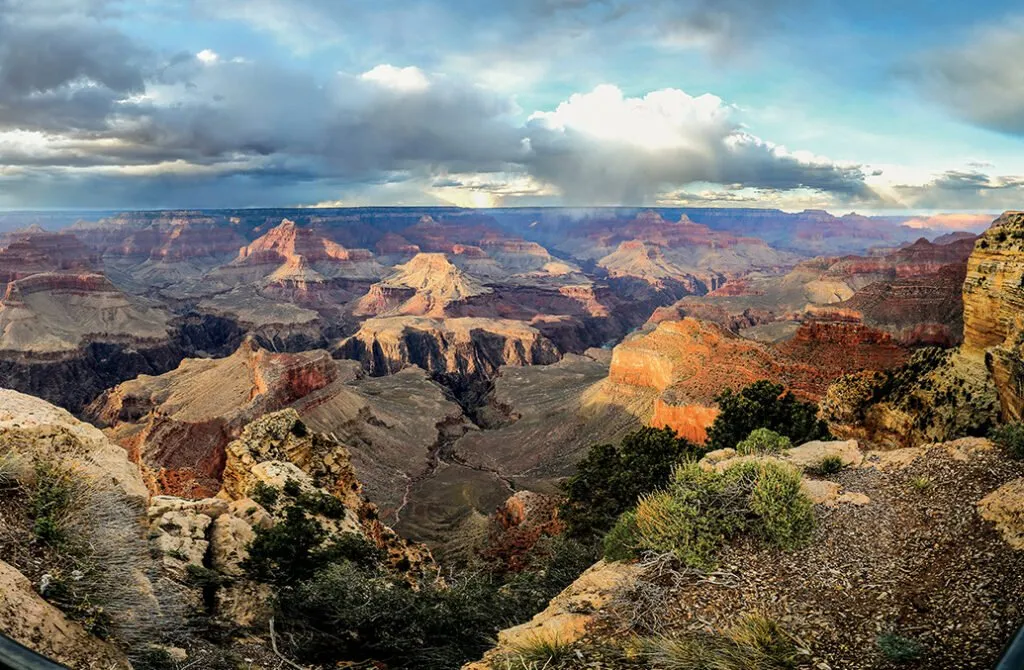Arizona, a state nestled in the southwestern United States, has long been celebrated for the majestic Grand Canyon and its seemingly endless deserts. However, beyond these iconic tourist destinations, Arizona harbors countless untouched, awe-inspiring wilderness areas, waiting to be discovered by adventurous souls. Join “Du lịch khắp thế gian” (Travel the World) as we unveil these hidden gems and immerse ourselves in the raw, pristine beauty of Arizona.
Arizona’s Diverse and Magnificent Geographical Beauty
Arizona boasts an incredibly diverse terrain, shaped by a complex interplay of geological factors, climate, and river systems. This diversity has sculpted breathtaking landscapes, making Arizona one of the most captivating travel destinations globally. From vast plateaus to deep canyons, from arid deserts to lush pine forests, Arizona is like a colossal natural canvas, constantly changing colors with each season.

Colorado Plateau: Land of Geological Wonders
Dominating northeastern Arizona, the Colorado Plateau is an expansive region characterized by towering cliffs, deep canyons, and verdant Ponderosa pine forests. It is not only home to a plethora of wildlife and rare plants but also the location of the Grand Canyon, one of the world’s most renowned natural wonders.
The Grand Canyon, carved over millions of years by the relentless erosion of the Colorado River, is a colossal gorge displaying layers of multicolored rock, chronicling the Earth’s geological history. Visitors can marvel at the Grand Canyon’s grandeur from various viewpoints, engage in hiking and backpacking adventures, or even experience the thrill of skydiving.

Basin and Range: Harmony Between Desert and Mountains
Located in southern and western Arizona, the Basin and Range region is distinguished by its characteristic topography of wide valleys interspersed with towering mountain ranges. This region exudes a raw, magnificent beauty, with a striking contrast between arid deserts and imposing rocky mountains. Despite the hot, dry climate, the Basin and Range supports a rich ecosystem, with numerous plant and animal species adapted to the harsh environment.
One of the most famous destinations in the Basin and Range is the Sonoran Desert, habitat of the giant Saguaro cactus, an iconic symbol of Arizona. Visitors can join desert tours to explore this unique ecosystem, observing wildlife such as jackrabbits, desert foxes, and native bird species.
Transition Zone: Confluence of Ecosystems
The Transition Zone, also known as the Central Highlands, is a complex geographical area situated between the Colorado Plateau and the Basin and Range. Characterized by a blend of plateaus, mountain peaks, and rolling highlands, the Transition Zone experiences a diverse climate, ranging from hot and dry in the south to cool in the north. This diversity has fostered a rich ecosystem, a meeting point for flora and fauna from both neighboring regions.
The Transition Zone is an ideal destination for those who love exploring wild nature. Visitors can hike through cool pine forests, climb mountains to admire breathtaking landscapes, or camp to enjoy the tranquility of this region. Notable locations within the Transition Zone include Sedona, with its spectacular red rock formations, and Prescott, with its extensive pine forests.
Arizona’s Rich History and Diverse Culture
Beyond its natural beauty, Arizona is a land rich in history and culture. From the remnants of Native American tribes to the influences of Spanish and American cultures, Arizona embodies a unique blend, creating a distinctive cultural identity.
Native American Culture: Priceless Heritage
Before European arrival, Arizona was inhabited by numerous Native American tribes, such as the Navajo, Hopi, Apache, and Tohono O’odham. These tribes developed unique cultures, with distinct customs, traditions, and traditional arts. Today, Native American culture remains vibrant in Arizona, with numerous historical sites, museums, and cultural centers allowing visitors to learn about the history and culture of these indigenous tribes.
One of the most important historical sites of Native American culture in Arizona is the Pueblo Grande Museum Archaeological Park in Phoenix. Here, visitors can explore the ruins of an ancient village of the Hohokam people, one of the most developed indigenous civilizations in the region.
Spanish Cultural Influence: Architectural and Culinary Imprints
In the 16th century, the Spanish arrived in Arizona, bringing their culture, religion, and architecture. The influence of Spanish culture is still evident in Arizona today, particularly in architecture and cuisine. Many historical buildings in Arizona feature Spanish colonial architectural styles, with white walls, red tile roofs, and spacious corridors.
Arizona’s cuisine is also heavily influenced by Spanish culture, with many dishes utilizing ingredients such as chili peppers, corn, and beef. Some famous Arizona dishes with Spanish origins include enchiladas, tamales, and tacos.
Modern American Culture: Development and Innovation
Since becoming a state in the United States in 1912, Arizona has experienced rapid economic and social development. Major cities like Phoenix and Tucson have become important economic, cultural, and educational centers in the region. Modern American culture has brought innovation and progress to Arizona in various fields, from technology to the arts.
Arizona is also home to many prestigious universities and colleges, attracting students from around the world. Arizona State University (ASU) is one of the largest and most reputable public universities in the United States.

Exploring Untamed Wilderness: Unique Experiences
Arizona is not only a famous tourist destination but also a raw, magnificent wilderness, waiting for adventurous hearts to conquer. Here are some suggestions for wilderness areas in Arizona that you can explore:
- Havasu Falls: Located in the Havasupai Reservation, Havasu Falls is a stunning waterfall with turquoise blue water cascading down red cliffs. To reach Havasu Falls, you need to hike or ride horses for about 10 miles.
- Antelope Canyon: Situated near Page, Antelope Canyon is a famous slot canyon with winding sandstone walls and sunlight beams creating magical light effects.
- Monument Valley: Straddling the border between Arizona and Utah, Monument Valley is a wilderness area with bizarrely shaped red rock formations, a backdrop for many famous Western movies.
- White Tank Mountain Regional Park: Located west of Phoenix, White Tank Mountain Regional Park is a nature preserve with numerous hiking trails, where you can explore canyons, waterfalls, and Native American petroglyphs.
Conclusion
Arizona is a diverse and captivating state, with magnificent natural beauty, rich history, and diverse culture. Beyond the famous tourist attractions, Arizona also hides countless untouched wilderness areas, waiting for adventurous hearts to conquer. Come to Arizona to discover these hidden gems and experience the fascinating wonders this land offers.